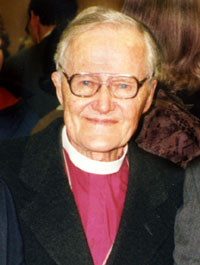This article is adapted from a post on the ABTS blog on July 26, 2018.
In my last blog post in February, I wrote about women in seminary. I based my main argument on the priesthood of all believers. In this post, I intend to dig deeper into this topic of priesthood.
What is the priesthood of all believers and why does it matter?
As I commented in my earlier post, the priesthood of all believers became one of the important tenets of the Protestant Reformation. This was widely understood as all individuals having equal and direct access to God without the need for ecclesiastical mediation. This understanding has caused many issues throughout the history of the church, and it was used to evade and undermine ecclesiastical authority.
The problem with this understanding, or misunderstanding, is that the role of priesthood in the New Testament was given to the community and not to individuals (example 1 Peter 2:9, Revelation 1:6). This is supposed to be a key element of the corporate identity of the people of God, of the Church. No wonder that this misunderstanding has led to the subtle move in practice from the priesthood of all believers to making a distinction between the general priesthood and the special priesthood to the inevitable priesthood of the ordained.
I believe, as Martin Luther repeatedly suggested, that the priesthood of all believers means that we are all priests, while priesthood is a corporate identity. I am convinced that the New Testament did not intend to create the clergy-laity divide that we find in our churches today, and Luther’s intention was to bring the Church back from its two-tier tradition.
This by no means implies that there are no leadership roles in the church or that ecclesiastical authority can be compromised. Rather, it means that every believer in the community is a full-time minister of the Gospel, set apart for ministry. Some are set apart for church-based ministry as leaders, equippers, and coaches. The rest are set apart for marketplace-based and workplace-based ministry in the world taking the Gospel to where the people are.

Bishop Lesslie Newbigin was a twentieth-century British theologian, missiologist, and author. He served most of his career as a missionary to India. He left a Christendom Britain to become a missionary in India, and then came back years later to a Britain that needed to be evangelized. (Christendom refers to the time when Christianity was the assumed religion of the West.) His writings* show how his theology of the Church developed from Christendom ecclesiology to missionary ecclesiology. This was due to his experience as a missionary, to his deep involvement within the ecumenical movement, and to his call for a missionary encounter with Western culture. Newbigin’s missionary ecclesiology became the precursor to what is more widely known today as missional ecclesiology.
During Christendom, people naturally went to “church” on Sunday. Hence, an emphasis on pastoral concerns, good preaching and teaching, in functional buildings was effective in nurturing people and influencing culture. Christendom ecclesiology served this attractional ministry model well, except for some obvious drawbacks. It contributed to creating a dichotomy within the Church between those who do and those who don’t, those who serve and those who are served. It reinforced the clergy-laity divide, and produced teams of ministers serving spectator congregations.
Missional ecclesiology puts its emphasis more on the missional incarnational ministries of the church, a church where every member views himself or herself as a minister and as a missionary to their context in their various spheres of influence. The emphasis is no longer on buildings or internal concerns. The Church gathers regularly to worship, to fellowship, and to be equipped for ministry, and then disperses into the world to serve.

What is surprising is that many churches in the West still base their ministry today on a framework of Christendom ecclesiology in a post-Christendom post-church culture with growing religious pluralism and increasing anti-church sentiment. What is more surprising is that the modus operandi of our Middle Eastern churches is an inherited Christendom ecclesiology. How can a Christendom church serve a religiously pluralistic Lebanon or a Middle East where Christianity is a minority?
A key element to ecclesiology is leadership. Who are the leaders of the Church? What is their function? Are they the ministers, or are they the equippers/coaches? The answers to these questions have a significant impact on shaping the ministry of the Church.
We call our primary church leader the “pastor”, or shepherd. Whether the implication is deliberate or not, the message being communicated is that the key spiritual gift of the primary leader should be shepherding, and that the shepherding needs of the Church are the main concern. Very much a Christendom ecclesiology framework.
The model presented by Paul in Ephesians 4 suggests a different framework:
And He gave some as apostles, and some as prophets, and some as evangelists, and some as pastors and teachers, for the equipping of the saints for the work of service, to the building up of the body of Christ; until we all attain to the unity of the faith, and of the knowledge of the Son of God, to a mature man, to the measure of the stature which belongs to the fullness of Christ. (Ephesians 4:11–13, NASB95)
God has given leadership spiritual gifts to the leaders of the Church for the primary purpose of equipping the members to do the work of ministry. If we were to give weight to the order of the gifts listed here by Paul, the gift of apostleship comes first. Why would not the key gift of the primary leader be apostleship? I understand the spiritual gift of apostleship to be the God-given ability to see and understand what God is doing in the community where the local church is located, what the needs of the people are, and how the church can engage its surrounding society through the presence of the members/missionaries there.
The gift of apostleship is key but not at the expense of the other gifts, including shepherding. A key part of equipping is caring for the people, restoring the broken, teaching and discipleship, and evangelism. But, perhaps primacy should be given to the gift of apostleship. This is the crux of missional ecclesiology.
So, what does all of this mean for us today? I suggest that rather than lamenting the Church losing its place at the center in the West, or operating from a self-perception of victimization and minoritization in the Middle East, we need to rethink our operative ecclesiology. We can start by listening to the voices of Martin Luther and Lesslie Newbigin.
Ecclesiology is the study of the Church, the body of Christ. It is not an abstract concept. On the contrary, it is at the center of “practical theology” where the Church meets the world. Understanding the role of the Church in the world is key. The way the world functions today is rapidly changing. Consequently, our methods for engaging the world should be adaptive. If we believe that the Church is merely an institution, then a static ecclesiology might suffice. However, if we believe that the Church is a living organism, constantly being moved by God to engage a changing world, then we need a living ecclesiology that is nimble and able to respond swiftly to what God is doing in our world.
__________________
* For a good read on Newbigin’s ecclesiology, refer to this soon-to-be-published volume: Goheen, M.W. and N.T. Wright. The Church and Its Vocation: Lesslie Newbigin’s Missionary Ecclesiology. Baker Publishing Group, 2018.
